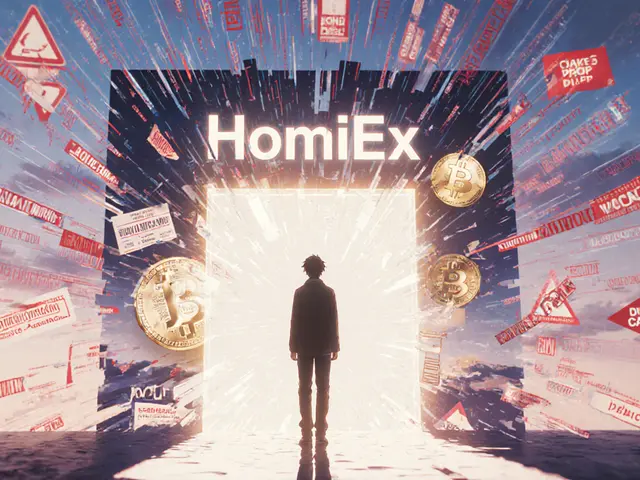LFJ v2.1 (BSC) Slippage Calculator
Trade Slippage Calculator
Trade Estimate
When you see the name LFJ v2.1 (BSC) is a decentralized cryptocurrency exchange built on the Binance Smart Chain (BSC), you probably wonder whether it’s worth your time.
What is LFJ v2.1 (BSC)?
LFJ v2.1 (BSC) is the BSC‑based branch of the broader LFJ ecosystem, originally launched on Avalanche as Trader Joe. In 2023 the team rolled out a multi‑chain version, adding support for Binance Smart Chain, Solana, Monad and several other networks. The idea is simple: give traders a single UI to hop between chains without juggling dozens of DEX apps.
Technical specs and the data‑reporting headache
One of the first things you’ll notice is the conflicting numbers across trackers. CoinGecko lists only one coin and one pair, with a 24‑hour volume of $0.00. CoinMarketCap, on the other hand, reports about $4,850 in spot volume and $628 in DEX volume for the same period. The discrepancy isn’t just a typo - it reveals that the platform’s analytics pipeline is still a work in progress.
Because the exchange runs on BSC, transactions cost a few cents in gas, but low liquidity means you’ll often see higher slippage than on PancakeSwap. The platform does not offer margin trading or traditional maker‑taker fees; you only pay the network fee.
Trading pairs, liquidity and what you can actually trade
Unlike PancakeSwap, which lists hundreds of tokens, LFJ v2.1 (BSC) currently offers a single trading pair. Wrapped versions of major assets like BTC and ETH may appear, but they are not native listings. This limited selection puts the exchange in the 8th percentile for activity among tracked DEXs, meaning you’ll likely encounter thin order books.
The multi‑chain promise sounds good on paper, but on BSC the execution feels half‑baked. If you need deep liquidity for a sizable swap, you’ll probably head to a larger platform first.
User experience and community vibes
Connecting a Web3 wallet is straightforward. LFJ supports MetaMask, Trust Wallet and WalletConnect, so the usual “Connect Wallet” button works as expected. However, the BSC version’s community footprint is tiny. While the overall LFJ brand boasts over 380 k Twitter followers, the BSC branch only sees about 2 k monthly page views on CoinGecko and almost no dedicated Reddit threads.
Because the user base is small, you won’t find many tutorials or user‑generated guides specific to the BSC version. Most of the documentation you’ll encounter talks about the Avalanche ecosystem instead.

Security audits and trust score
LFJ’s core contracts have been audited by HashEX and Paladin, giving the platform a baseline level of credibility. The audits cover the smart‑contract logic for swaps, liquidity pools and the launchpad. Yet, the BSC branch lacks a dedicated audit report, so you’re essentially relying on the same codebase that runs on other chains.
In practice, the trust score sits in the “acceptable” range for DEXs, but the low volume means there’s less real‑world stress testing of the contracts on BSC.
How to trade on LFJ v2.1 (BSC)
- Install a BSC‑compatible wallet (MetaMask, Trust Wallet, etc.) and add the BSC network.
- Visit lfj.gg and click “Connect Wallet”.
- Select the available trading pair from the drop‑down menu.
- Set your slippage tolerance - because liquidity is thin, a 2‑3 % buffer is a good starter.
- Confirm the transaction and pay the BSC gas fee (usually <$0.02).
Remember, there’s no KYC, so you keep full control of your private keys, but you also bear the full risk of smart‑contract bugs.
LFJ v2.1 (BSC) vs. the big BSC players
| Feature | LFJ v2.1 (BSC) | PancakeSwap | 1inch |
|---|---|---|---|
| Launch Year | 2023 | 2020 | 2020 |
| Supported Chains (main UI) | Multi‑chain (BSC, Avalanche, Solana, Monad) | Binance Smart Chain only | Multi‑chain aggregator |
| Number of Trading Pairs (BSC) | 1 | ~3,500 | ~2,800 |
| 24‑h Volume (approx.) | $4,800 | $1.2 B | $750 M |
| KYC Required | No | No | No |
| Unique Feature | Unified multi‑chain UI for LFJ ecosystem | Largest BSC liquidity pool | Best‑price routing across DEXs |
What does this mean for you? If you’re chasing deep liquidity or a wide token selection on BSC, PancakeSwap or 1inch will feel far more comfortable. LFJ’s strength is the ability to hop to Avalanche or Solana without leaving the app - but you’ll only see that benefit once the BSC branch grows its own pool of assets.

Pros, cons and the bottom line
- Pros
- Low entry barrier - no KYC, easy wallet connection.
- Part of a larger multi‑chain ecosystem, useful for cross‑chain traders.
- Audited core contracts (HashEX, Paladin).
- Cons
- Only one trading pair on BSC, very thin liquidity.
- Conflicting volume data across trackers.
- Minimal community support and documentation for the BSC version.
- Higher slippage risk for larger trades.
If you’re an early‑adopter who loves experimenting with new DEXs and you don’t mind tiny trade sizes, LFJ v2.1 (BSC) can be an interesting sandbox. For most traders looking for reliable execution on BSC, sticking with PancakeSwap or a multi‑chain aggregator like 1inch is still the safer bet.
Key takeaways from this LFJ v2.1 BSC review
LFJ v2.1 (BSC) is a technically sound but under‑populated exchange. Its multi‑chain ambition is promising, yet the BSC implementation lags behind the competition in liquidity, pair variety and community momentum. Expect modest slippage on tiny swaps, and keep an eye on future updates if the team ramps up its BSC offering.
Frequently Asked Questions
Is LFJ v2.1 (BSC) safe to use?
The core contracts have been audited by HashEX and Paladin, which gives a baseline level of security. However, the BSC branch lacks a dedicated audit, so treat it like any other newer DEX - use small amounts first.
How many tokens can I trade on LFJ v2.1 (BSC)?
Currently only a single pair is listed on the BSC version. Wrapped versions of major assets may be available, but the official token list is very limited.
Do I need to complete KYC?
No. Like most DEXs, LFJ v2.1 (BSC) requires only a compatible Web3 wallet. Your identity stays private.
What wallet should I use?
MetaMask, Trust Wallet and any WalletConnect‑compatible app work out of the box. Just make sure the wallet is set to the Binance Smart Chain network.
Will LFJ add more pairs on BSC?
The team has hinted at future expansions across all chains, but no concrete roadmap for BSC has been published yet. Keep an eye on their official Twitter for announcements.



Marina Campenni
April 8, 2025 AT 00:57I noticed the liquidity on LFJ BSC is really thin, which means slippage can bite you even on small swaps. The gas fees are cheap, but that advantage disappears when you have to use a larger buffer. If you’re just testing the UI, it’s straightforward to connect MetaMask or Trust Wallet. For anyone looking for deeper markets, the limited pair list is a real drawback. It might be worth keeping an eye on future updates before committing significant capital.
Irish Mae Lariosa
April 9, 2025 AT 04:43The platform's current state presents a series of shortcomings that merit detailed examination. First, the volume discrepancy between CoinGecko and CoinMarketCap is not a trivial typo; it signals an incomplete analytics pipeline. Second, offering only a single trading pair on a multi‑chain label contradicts the advertised ambition of seamless cross‑chain swaps. Third, thin order books inevitably inflate slippage, making even modest trades costly despite the low BSC gas fees. Fourth, the absence of a dedicated BSC audit means users are relying on code that has not been stress‑tested on this specific network. Fifth, the limited community footprint is minuscule, with limited tutorials and a near‑nonexistent Reddit presence, which hinders onboarding for newcomers. Sixth, while the UI mirrors that of the Avalanche version, the underlying liquidity pools are shallow, creating a mismatch between user expectations and reality. Seventh, the lack of maker‑taker fee structures removes a common incentive for liquidity providers to supply depth. Eighth, the platform does not support margin trading, further narrowing its appeal to advanced traders. Ninth, the token listings are limited to wrapped assets, which may introduce additional risk layers for users unfamiliar with cross‑chain wrapping mechanisms. Tenth, the documentation primarily addresses the Avalanche ecosystem, leaving BSC users to extrapolate or guess at critical parameters. Eleventh, the slippage tolerance recommendation of 2‑3% is high compared to more mature DEXs, reflecting the underlying liquidity issues. Twelfth, the reliance on a single smart‑contract codebase across multiple chains could create systemic vulnerabilities if an exploit is discovered. Thirteenth, the trust score falls into an acceptable range, but such a rating is less meaningful when real‑world transaction volume is negligible. Fourteenth, the platform’s marketing appears to overpromise on cross‑chain capability without delivering the necessary infrastructure. Fifteenth, prospective users should weigh the convenience of low gas fees against the tangible risks of low liquidity and limited auditing. Finally, if you value robust security and deep markets, it may be prudent to explore larger, more established BSC DEXs before allocating significant capital to LFJ v2.1.
Nick O'Connor
April 10, 2025 AT 08:30When I first connected my wallet, I was impressed by the clean interface, however, the subsequent experience revealed notable limitations, especially regarding liquidity, which, as many have observed, can result in substantial price impact; additionally, the scarcity of trading pairs further restricts utility, and while the low gas fees are appealing, they do not compensate for the broader shortcomings, so prospective traders should proceed with caution.
DeAnna Brown
April 11, 2025 AT 12:17Wow, you guys, this exchange really tries to sell the dream of a one‑stop‑shop for all chains, but in practice it feels like a half‑baked pastry-pretty on the outside, but hollow inside! The single pair on BSC is a joke, and the community is practically nonexistent, which means if you run into any hiccups you’ll be left holding the bag. Sure, the gas is cheap, but who cares when you’re losing half the trade to slippage? If anyone is hoping to find the next big DeFi jackpot here, you might be better off sticking with PancakeSwap until they actually deliver on their promises. Stay safe out there, folks!
Chris Morano
April 12, 2025 AT 16:03It’s true that the current liquidity is thin, but I think the developers are still early in their roadmap, and there’s room for the community to help bootstrap the pools. If more users start providing liquidity, the slippage could improve over time, and the multi‑chain vision might finally materialize. Patience and a little optimism could turn this into a useful platform down the line.
Carolyn Pritchett
April 13, 2025 AT 19:50This is exactly why the whole LFJ hype is a scam-people hype up “multi‑chain” nonsense while delivering nothing but an empty interface and zero volume. Anyone who actually tried a swap would see how the thin order book eats your profit instantly. It’s a classic rug‑pull waiting to happen, and the so‑called “low gas fees” are just a distraction. Avoid it like the plague.
lida norman
April 14, 2025 AT 23:37😱 I can’t believe you’re being so harsh! I get the frustration, but the project still has a tiny community that’s trying to grow, and some people actually find the UI intuitive. Let’s not dismiss everything before giving it a chance-maybe the next update will bring real liquidity. Keep an open mind, okay? 🙏
Devi Jaga
April 16, 2025 AT 03:23Oh, absolutely, because “tiny community” automatically translates to “future liquidity tsunami,” right? One could argue that the current thinness is merely a “beta‑phase liquidity vacuum”-a standard industry term for “we haven’t attracted market makers yet.” So, let’s all just sit back and watch the “liquidity portal” manifest itself out of thin air, shall we?
Matthew Theuma
April 17, 2025 AT 07:10From a philosophical standpoint, the pursuit of an all‑encompassing DEX mirrors humanity’s quest for a unified theory of everything-beautiful in concept but fraught with practical constraints. The trade‑off between low transaction costs and market depth is akin to the classic tension between simplicity and richness in art. While the BSC version offers cheap gas, the scarcity of assets creates a barren landscape, much like a minimalist canvas lacking color. If we accept that every system has inherent limitations, perhaps we can appreciate LFJ v2.1 as a stepping stone rather than a final destination. 🧐
Jason Zila
April 18, 2025 AT 10:57The analogy to art is apt, and the reality is that without sufficient liquidity providers, even the most elegant UI becomes a shell; developers need to incentivize LPs, perhaps through token rewards or partnerships, to transform this minimalist view into a vibrant marketplace.
Cecilia Cecilia
April 19, 2025 AT 14:43The current volume is insufficient for serious traders.
Jessica Cadis
April 20, 2025 AT 18:30While the numbers may look modest, it’s important to remember that emerging DeFi platforms often start small before gaining cultural traction within niche communities, and that growth can be exponential once awareness spreads.
Katharine Sipio
April 21, 2025 AT 22:17Stay positive, everyone! Even a modest DEX can evolve into a robust ecosystem with the right support and community engagement.
Shikhar Shukla
April 23, 2025 AT 02:03While optimism is commendable, it must be balanced with rigorous analysis of the platform’s technical architecture and market dynamics to ensure that expectations are grounded in realistic assessments.
David Moss
April 24, 2025 AT 05:50The “realistic assessments” you speak of are often curated by hidden agendas; remember that many “audits” are funded by the same entities that stand to profit, so the trust score may be a façade-stay vigilant!